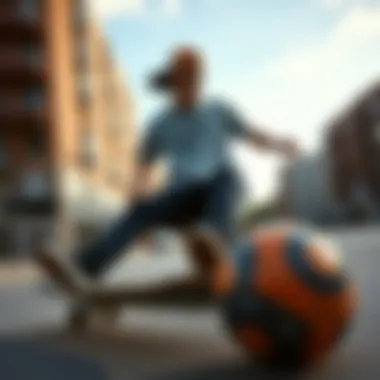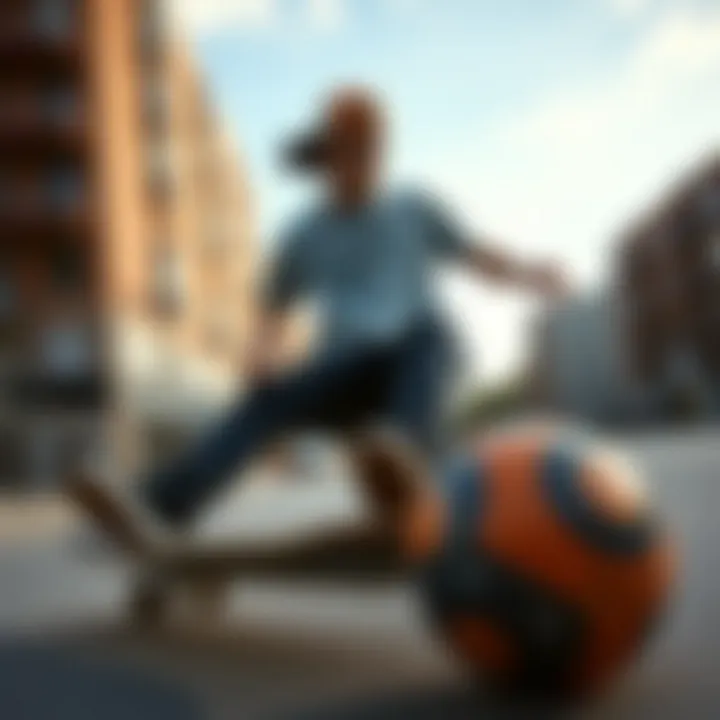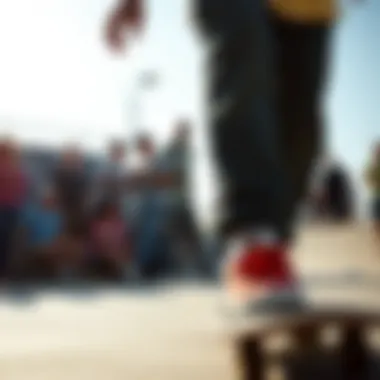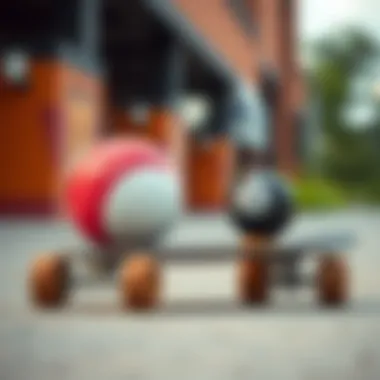Exploring the One-Ball Skateboard: Design and Impact


Intro
The one-ball skateboard is a fascinating addition to the skateboarding landscape, giving riders a fresh avenue for expression, creativity, and skill development. Its unique design revolves around a single spherical wheel nestled at its center, allowing for a distinct riding experience compared to traditional skateboards, which typically utilize multiple wheels. This feature elevates not just the mechanics of riding but also introduces a barage of new tricks and maneuvers that challenge even seasoned skateboarders.
Beyond the technical aspects, the one-ball skateboard has sparked a buzz in skate communities across the globe. Many view it as an innovation that enriches the culture, providing skateboarders at all levels unique opportunities to connect, grow, and contribute. It’s more than just a board; it’s a symbol of adventure and ingenuity that has begun to shape a new narrative in the skateboarding world.
In exploring the one-ball skateboard, this article navigates through its historical context, operational mechanics, and the community's response. By dissecting these elements, the aim is to provide insights that resonate with skateboarders, instructors, and shop owners alike, cultivating a broader understanding of this captivating tool and its impact on skate culture.
Skills Development
As skateboarders take the plunge into the world of the one-ball skateboard, skill development becomes a priority. The broad horizon of tricks and maneuvers available with a single-wheel design opens up a fresh set of possibilities, challenging riders in new ways. Understanding these skills enhances not only individual performance but fosters a deeper engagement with the skateboarding community.
Trick Tutorials
Learning tricks on a one-ball skateboard can differ significantly from conventional boards. New techniques can be tricky, so breaking them down into digestible tutorials can demystify the process. For example, consider mastering a trick called the “one-ball ollie.” This variation of the classic ollie requires precise timing and balance, as riders must use their entire weight to lift off while keeping their feet steady.
- Balance: The core principle of keeping your weight centered over the ball is crucial.
- Lift: As you push off with your back foot, ensure your front foot drives down while leaning slightly forward.
- Landing: Practice makes perfect; getting accustomed to landing smoothly can take time.
This example highlights how the dynamics of the one-ball skateboard promote a different kind of balance and finesse. Similarly, more advanced tricks will involve combinations of spins and flips, which push riders even further beyond their comfort zones.
Skill Progression Tips
To truly excel, rider can implement a few essential strategies:
- Consistent Practice: Regularly riding your one-ball board can build the muscle memory needed for various tricks.
- Observation and Adaptation: Watching fellow riders, particularly those who excel on a one-ball skateboard, can offer invaluable insights into technique.
- Feedback Loop: Engaging with the skating community provides feedback that allows for personal growth and new ideas.
Embracing these practices not only hones skills but also contributes to a vibrant culture where collaboration and support thrive.
Gear Insights
The right gear plays a pivotal role in the successful experience of riding a one-ball skateboard. As its popularity grows, understanding the right products and safety measures becomes vital.
Skateboard Reviews
Various one-ball skateboard brands are emerging, each offering different features that cater to diverse preferences. For instance, the Onewheel is praised for its intuitive ride and durability, suitable for both tricks and leisurely rides. Another option to consider might be the Swell, a skateboard known for its unique design aesthetic. Each skateboard offers a flavor tailored to individual riders.
Safety Equipment Recommendations
Safety should never be overlooked, especially as riders tackle new terrains and tricks. Ensuring proper equipment can drastically reduce the risk of injury. Here are a few essential safety gear suggestions:
- Helmets: A comfortable, well-fitting helmet is non-negotiable; it guards against head injuries.
- Knee Pads: For those learning new tricks, knee pads can prevent scrapes and bruises.
- Elbow Pads: Similar to knee pads, elbow guards are critical for protecting against falls.
The merging of safety and style ensures that as the one-ball skateboard gains traction, riders can embrace their prowess on the board while remaining protected.
“The essence of skateboarding is not just in the tricks but the community that forms around it.”
In summation, the one-ball skateboard is more than just another item on the market. Its unique design and functionality spark endless opportunities for skill growth and community engagement. As this new trend unfolds, embracing both the artistic aspects of riding and the practicality of safety gear ensures its potential to enhance skate culture at large. Links to further resources can provide additional insights, including Wikipedia, Britannica, and community boards on Reddit for ongoing discussions.
Preamble to One-Ball Skateboards
The advent of the one-ball skateboard marks a pivotal development in the skateboarding world. It shatters the conventional norms that have dictated skateboard design for decades. Why should we take a closer look? Because understanding this innovative alteration invites insights into the evolution of skateboarding, highlighting not just its mechanics but the culture it fosters.
Exploring the one-ball skateboard isn't just about aesthetics or novelty; it’s about recognizing the benefits that this unique design can provide to skaters. For example, the incorporation of a single central wheel encourages riders to rethink balance and maneuverability, setting a stage for new tricks and styles.
Moreover, the considerations around these boards are multifaceted. They don't merely challenge traditional practices but also push riders to enhance their skills in ways that traditional boards do not. With the one-ball design, skaters tap into a realm that merges creativity and functionality, often broadening their skill set.
The unique shape and build of one-ball skateboards create a dialogue among skaters—it's not simply a matter of riding; it transforms skateboarding into an expression of individuality and community interaction. As riders begin to embrace this innovative style, they contribute to a culture that values pioneering spirit and adaptability.
In the sections that follow, we will delve deeper into the historical significance, mechanics, and cultural ramifications of the one-ball skateboard. Through this exploration, it becomes clear that the one-ball skateboard stands not just as a piece of equipment but as a symbol of innovation and community in a sport that constantly evolves.


"Skateboarding is more than just sport; it’s a means of expressing oneself through motion and creativity. The one-ball skateboard elevates this interaction to an entirely new level." - A passionate skateboarder.
Thus, grasping the essence of the one-ball skateboard offers a chance to appreciate broader implications within the skateboarding community, making it a vital subject of inquiry.
Historical Context of Skateboarding
Understanding the historical context of skateboarding is crucial for grasping how variations like the one-ball skateboard have emerged. Skateboarding has not only been a sport but also a cultural phenomenon that reflects social changes over decades. From its surf-inspired origins to the extensive customization and niche communities we see today, the evolution of skateboard design tells a comprehensive story of innovation and rebellion.
The Evolution of Skateboard Design
Initially, skateboards were simple wooden planks with metal wheels, designed mainly for inline skating mimicking surf tactics on the asphalt. As the sport gained traction in the 1970s, advancements in materials and design began taking shape. The introduction of polyurethane wheels revolutionized the ride, making the boards faster and safer. The shape also underwent massive changes — from the narrow boards of early days to the wider, more maneuverable designs seen later.
Throughout the 1980s and 1990s, the creativity of skateboarders began to dictate the evolution of board designs, leading to the rise of tricks that demanded a more specialized shape. This led to the introduction of concave decks that allowed for improved grip and control — a significant pivot in user experience. As skateboarders pushed boundaries, designs catered specifically to street skating began to emerge, and this is where we see the early inklings of what would eventually become alternative skateboards, including the one-ball variation, which was born out of a desire for something unique and different.
Preface of Alternative Skateboards
As the scene matured, so did the designs of skateboards. The market began to embrace alternative designs in the early 2000s. One notable shift was the rise of longboards, which catered to a different demographic with a focus on cruising and downhill racing rather than performing tricks. However, the introduction of the one-ball skateboard correlated with a specific desire for innovation and novelty rather than functional necessity.
One-ball skateboards, with their distinct single-ball wheel mechanism, showcased a break from tradition. They offered a different riding experience, focusing on balance and fluidity rather than conventional up-and-down movements. This sort of board aims to expose riders to a sense of freedom, akin to surfing but on solid ground. Enthusiasts are drawn to them for the challenge they present and the unusual experience that diverges from regular skateboarding norms.
The emergence and adoption of these alternative skateboards speak volumes about community dynamics. Riders, looking for a fresh experience or perhaps a new set of challenges, turned to variations like the one-ball skateboard not just as a tool for sport, but as an expression of individuality.
The historical development of skateboarding illustrates its dynamic nature and the continuous cycle of innovation spurred by riders' desire for change. Different eras and movements within the skateboard community have often paved the way for the emergence of unique designs and models.
As we explore the one-ball skateboard further, understanding its place within this broader historical tapestry enhances our appreciation of its unique attributes.
Mechanics of the One-Ball Skateboard
The mechanics of the one-ball skateboard signify not just its operation, but also the underlying principles that differentiate it from traditional skateboards. Understanding these mechanics opens the door to appreciating how this design fulfills the needs and aspirations of skaters. This section examines the integral structural features and the materials used in these boards, alongside their balance and stability—certainly key aspects that contribute to user experience.
Structural Features and Materials Used
The one-ball skateboard boasts a unique construction, with its defining feature being the singular ball mechanism that acts as both a wheel and pivot point. This design breaks away from the traditional four-wheel layout, posing alternative approaches to riding and maneuverability.
Materials play a crucial role in the skateboard's performance. High-grade plastic and rubber are often utilized to allow for robust yet responsive riding. The body of the skateboard is generally molded from composite materials, making it lightweight while ensuring durability.
Some common materials include:
- Polyurethane: For the one-ball, a softer polyurethane can absorb shocks better, providing smoother landings and a comfortable ride on uneven surfaces.
- Aluminum: Typically used for the skateboard’s frame, aluminum provides strength without adding unnecessary weight.
- Carbon Fiber: In high-end models, carbon fiber adds rigidity and minimizes weight, enhancing the overall performance.
The innovation in structural features doesn't just stop there. The positioning of the ball below the board serves a dual function: it allows for intricate tricks and enhances fluidity of movement. The way the ball is integrated also affects how balance is distributed across the board, shifting the dynamics of riding significantly.
"What makes the one-ball skateboard exhilarating isn't just how it rolls but how completely different it feels under your feet," says Alex, a pro skateboarder.
Balance and Stability Analysis
When it comes to the balance and stability of the one-ball skateboard, there's a larger conversation happening about how this design interacts with the rider’s body. The single pivot point fundamentally alters the physics of riding.
Compared to traditional boards, where balance is distributed evenly across four wheels, riding a one-ball skateboard requires adaptive techniques. Riders must engage their core muscles more actively to maintain stability as the board shifts on the ball. This demands improved proprioception and balance skills, making it a more challenging yet rewarding experience.
Several factors contribute to this balance dynamics:
- Center of Gravity: The position of the rider affects stability. With a lower center of gravity, skaters can maneuver more effectively, especially when executing tricks.
- Weight Distribution: Riders must be cognizant of how their weight shifts as they navigate turns; the ability to shift weight effectively can prevent falls and enhance control.
- Surface Interaction: Finally, the type of surface matters. A smoother surface offers better stability compared to rough terrains, affecting how the one-ball skateboard manages grip and friction.
Skaters engaging with this unique board might find initial challenges in maintaining balance, yet the learning curve is often met with excitement as they develop new skills. This creates a sense of community among riders, many of whom are eager to share tips and tricks on forums like Reddit and other social media platforms.
As we continue to explore the nuances of the one-ball skateboard, understanding these mechanics helps embed its significance in the larger narrative of skateboarding culture.
Comparative Analysis with Traditional Skateboards


Analyzing the one-ball skateboard in relation to traditional skateboards is paramount for understanding its place in the evolution of skate culture. This section not only compares basic functions but also dives deeper into nuanced parameters that differentiate these two styles. One significant aspect to deliberate upon is how each design influences performance metrics and user experience, both of which are fundamental for skate enthusiasts keen to choose the right board for their needs.
Performance Metrics
When we take a closer look at performance metrics, the one-ball skateboard certainly brings some peculiar characteristics to the table. Traditional skateboards typically have a broader deck and multiple wheels, making them stable but less adept at certain maneuvers. In contrast, the one-ball skateboard employs a singular wheel that can alter the dynamics of balance significantly. This difference leads to a few noteworthy performance aspects:
- Speed and Agility: The one-ball skateboard allows for swift transitions between turns, giving riders a unique edge when it comes to agility. Riders often observe a feeling of "floating" as they navigate, which can be both thrilling and chaotic.
- Turning Radius: With its single wheel, the one-ball skateboard has a tighter turning radius than traditional boards, which can be beneficial for quick maneuvers in crowded areas or skate parks.
- Acceleration and Braking: The mechanics of propulsion and braking behave differently; while pushing off on a traditional board is straightforward, the single-wheel setup offers an unusual experience, requiring greater practice to master.
"Riding a one-ball skateboard feels like you're defying the laws of physics—you're stabilized by this single point, and it can be roundly addictive once you get the hang of it."
In scenarios where speed and quick direction changes matter—such as urban environments—the one-ball skateboard could very well prove superior. So when examining which option is best for certain activities, it’s wise to consider the skill level and preferences of the skater.
User Experience and Preferences
The user experience for one-ball skateboards differs widely from that of traditional boards. Skaters, especially those accustomed to the standard four-wheel setups, express varied opinions, shaped largely by what they seek in their riding experiences. Some key points emerge in understanding user preferences:
- Learning Curve: Many find that learning to ride on a one-ball skateboard demands a higher level of dedication and focus. This can deter casual users but attract those eager for a challenge. Some skaters compare it to learning a new language; persistence is key, and the rewards are plentiful.
- Rider Community: The community surrounding one-ball skateboards is often described as more niche, which means new users may find it easier to forge deeper connections with fellow enthusiasts. This intimacy can lead to structured meetups or collaborative learning environments as opposed to the more chaotic nature of traditional skateboarding circles.
- Personalization: There’s an artistry to customizing a one-ball skateboard. Riders tend to take pride in personalizing these boards, with a variety of designs and colors available on the market. This contrasts with traditional boards that often see less emphasis on unique design, which can be seen as standardization.
In sum, the comparative analysis of performance metrics and user experience highlights essential facets of the one-ball skateboard that differentiate it from traditional designs. Each skateboard resonates differently depending on the rider's style, community involvement, and ultimate intentions—be it casual riding or pushing boundaries in performance.
In considering these aspects, skaters can make a more informed choice, ensuring a fun and satisfying experience regardless of the board they choose.
Safety Considerations for One-Ball Skateboard Users
When it comes to skateboarding, safety is more than just a buzzword; it’s a fundamental aspect that can make or break the experience. Particularly with innovative designs like the one-ball skateboard, understanding safety considerations is crucial for both new and seasoned users. This section investigates the unique safety risks associated with one-ball skateboards and provides best practices for safe riding. Knowing these aspects can enhance not only individual safety but also the sense of community among skateboard enthusiasts.
Inherent Risks Compared to Conventional Boards
One-ball skateboards, unlike their traditional counterparts, come with a unique set of risks that stem from their distinct design. First off, the balance mechanism is quite different. With a one-ball skateboard, the central point of contact is radically altered, making it less intuitive for riders who are accustomed to the two-axle system of traditional skateboards. Some skaters might find themselves wobbling more than usual as they adjust to the new dynamics, leading to falls or injuries.
- Center of Gravity: The singular wheel fundamentally shifts the center of gravity. Riders must adjust their weight distribution carefully to avoid toppeling over.
- Speed Regulation: Since these skateboards can roll differently, managing speed can become tricky. You might hit a bump on the road, and rather than absorbing it, you could lose control in a split second.
- Brake Limitations: Unlike traditional boards, which allow for a variety of stopping techniques, the one-ball skateboard offers limited options to come to a quick halt. It’s crucial to recalibrate usual stopping methods.
"Understanding these inherent risks not only prepares the user but also fosters a culture of mindfulness within the skating community."
These risks can be mitigated through preparation and education, but it's crucial for riders to recognize the differences in order to skate safely.
Best Practices for Safe Riding
Riding a one-ball skateboard isn’t inherently dangerous, but riders must instill safe practices to enjoy the experience without incidents. Here are several guidelines that can make a difference:
- Wear Protective Gear: Simple yet effective, wearing a helmet, knee pads, and elbow pads can save you more than a few scrapes. Protecting your limbs provides essential cushioning against falls.
- Gradual Learning Curve: If you’re new to one-ball skateboards, begin practicing in a safe, open space where you can familiarize yourself with the balance and maneuvering of the board before hitting busier areas.
- Low Speeds at First: Maintain a slower pace as you adjust. This provides an opportunity to learn the board’s response to balance shifts and turns.
- Visual Awareness: Keep your eyes peeled for obstacles. Always remain alert to the environment around you. Unforeseen hazards can be less forgiving on a one-ball skateboard.
- Regular Board Checks: Before setting off, inspect the skateboard for damage or wear. A loose part can lead to unexpected issues while riding, making pre-ride checks critical.
By following these best practices, users can enhance their overall riding experience while minimizing potential risks. The one-ball skateboard provides a refreshing twist on traditional skateboarding, but safety must remain at the forefront for it to be thoroughly enjoyable.
The Appeal of One-Ball Skateboards
The attraction of one-ball skateboards is intricate and multifaceted. This type of skateboard is not just a new gadget; it embodies innovation in design and transcends traditional skating experiences. Understanding what makes the one-ball skateboard appealing necessitates exploring its target demographics and how it resonates on a cultural level, as well as the trends dominating the skateboard market today.
Target Demographics and Market Trends
Target demographics for one-ball skateboards vary significantly, potentially encompassing various age groups and skill levels. Youths, especially those falling within the ages of 12 to 25, make up a substantial portion of the market. This generation is less concerned with adherence to conventional methods and more open to experimentation, which is a perfect fit for the innovative design of the one-ball skateboard. Here are some profiles that exemplify this demographic:
- Beginner Skaters: With a lighter and unique design, one-ball skateboards offer an accessible entry point for those new to skating.
- Urban Commuters: Many city dwellers are looking for efficient and fun means of transport. The compact design fits well in crowded environments.
- Trendsetters and Influencers: Those keen on being at the forefront of skate culture often gravitate towards unique products, promoting their use via social media platforms.
Market trends show that there is an increased demand for alternative skateboards that stand out from traditional ones. Online platforms and marketing strategies focus heavily on visual storytelling and community engagement. Brands capitalize on this by showcasing user-generated content, thereby creating a sense of belonging among users. This dynamic not only fosters a community but also enhances brand loyalty.
Cultural Significance and Community Response
The cultural significance of one-ball skateboards extends beyond just being a piece of equipment; they challenge the very notion of what skateboarding means. The emergence of the one-ball skateboard has sparked discussions about adaptability and creativity in skating styles. It is equally about breaking boundaries and redefining norms.


Communities across the globe respond to this with mixed feelings. For some, the one-ball skateboard symbolizes progress and innovation. Enthusiasts laud its different riding experience, claiming it promotes new techniques and styles not possible on standard skateboards. For instance, tricks that require a particular weight distribution can be effectively executed on a one-ball skateboard, making it exhilarating for adventurous riders.
However, traditionalists may regard the one-ball skateboard with skepticism, viewing it as a mere novelty. They argue that this variation detracts from skills developed on conventional boards. These conversations beget 'showdown events' within communities, where riders can try out both types and share experiences.
The community response is further fueled by social media activity. Posts showcasing new tricks or creative configurations with the one-ball skateboard often go viral, contributing to the notion that it is at the cutting edge of skating culture. User stories—whether through Instagram reels or YouTube reviews—amplify the excitement surrounding the one-ball community, providing immediate feedback to manufacturers and shaping future designs.
"Innovation in skateboards isn't just about new wheels or decks; it's about revolutionizing what it means to skate," says urban skater and influencer Jake Hall.
Expert Insights and Reviews
Understanding the perspective of experts in the skateboard community is crucial for grasping the one-ball skateboard's impact and capabilities. Insight from professional skaters and recreational users not only lends credibility to our findings but also provides a real-world application of theoretical concepts. Evaluating reviews and testimonials illuminates the unique strengths and weaknesses of the one-ball design, aiding potential buyers in making informed decisions. Additionally, these expert accounts help in shaping community norms and expectations, influencing how the one-ball skateboard is perceived and utilized.
Testimonies from Pro Skaters
Pro skaters, being at the pinnacle of skill and experience in skateboarding, offer valuable insights into the performance and versatility of the one-ball skateboard. They hold the cachet of credibility; their evaluations can sway public opinion significantly. For instance, a professional skater who specializes in technical tricks might highlight the board's responsiveness and maneuverability. They might say something like, "With a one-ball skateboard, the ability to tilt and roll in quick succession offers a feeling akin to surfing on asphalt. It shifts my weight differently, which affects how I perform some tricks."
This approach mirrors cocnlusions that experts draw from rigorous practice and experimentation. It’s through their feedback that potential gaps in design or functionality are revealed. A common thread among their testimonials often revolves around a preference for the balance and stability offered by traditional skateboards when performing tricks, yet they acknowledge the unique ride experience a one-ball skateboard delivers. The contrasting perspectives can serve as a source of inspiration for future iterations of the design, addressing professional feedback while also catering to the recreational user's needs.
Feedback from Recreational Users
Whereas professional skaters focus more on technical performance, recreational users provide a broader spectrum of feedback, showcasing the one-ball skateboard’s usability for diverse skill levels. Many enthusiasts appreciate the lightweight design, which makes it easier to transport. They often mention, "I can easily toss it in the back of my car, and it’s perfect for short rides around the neighborhood without feeling clunky."
In addition, their insights tend to revolve around comfort and access to skating. Casual users may express a desire for enhanced stability during slow-speed rides, pointing out moments where the board could feel precarious. This feedback allows for an essential balance between versatility for quicker, nimble movement while addressing stability concerns for riders, particularly beginners.
"The one-ball skateboard is a refreshing addition to my casual rides. I felt I had to be more aware of my weight distribution, which made the learning process a fun challenge."
As they navigate the intricacies of the board, recreational users shed light on how the one-ball skateboard garners interest among non-skaters as well, potentially inviting a new generation into the skateboarding community. Highlighting both professional and user testimonials ensures that the evaluation of the one-ball skateboard is well-rounded, appealing to both those seeking thrills and those looking for leisure.
Future of One-Ball Skateboards
The trajectory of one-ball skateboards is shaped by a blend of current trends and potential innovations that could elevate their place in the skateboarding culture. A critical aspect of this discussion revolves around understanding how the design and functionalities mesh with the needs of contemporary skateboarders. The future isn’t just about what these boards can do; it’s also about how they will integrate into the community and reshape the identity of skating.
Innovations on the Horizon
As technology evolves, so does the potential for the one-ball skateboard. Future innovations may pivot towards not just enhancing performance but also towards personalization and user interaction. For instance, the integration of smart technology could transform how skateboarders engage with their boards. Picture a skateboard that communicates performance metrics via a dedicated app—riders could receive real-time feedback on balance, speed, and even safety features, further minimizing risk.
Moreover, advancements in materials could mean lighter, more flexible boards that retain durability. This is where 3D printing could play a significant role, allowing for custom designs that speak directly to an individual skater’s taste and style.
"The next wave of skateboards might let riders do more than carve their way through the streets; they could personalize their ride in ways we've only dreamt of."
Potential innovations might also include enhanced grip systems using advanced rubber composites that offer better traction without sacrificing feel. This step alone could open doors for more daring tricks and smoother rides. Sustainable practices are likely to come into play too. Boards made from recycled materials or wood sourced from sustainable forestry could resonate with eco-conscious consumers.
Potential for Community Expansion
The communal aspect of skateboarding holds immense potential for growth and evolution as more skateboarders embrace the one-ball design. Engaging communities around this unique type of skateboard can forge a deeper bond among riders. Collaborations between brands, local skateboard shops, and community organizations could create workshops or events that allow newcomers to learn and experiment with these boards.
Furthermore, fostering a culture that promotes inclusivity is vital. Events could highlight diverse skill levels, encouraging everyone from beginners to seasoned pros to participate, which fosters growth in numbers and skills alike.
Skateboarding isn’t just about individual prowess; it’s about the collective energy that everyone brings. With the rise of one-ball skateboards, there’s an opportunity to capture that spirit and channel it into building new connections among riders of all backgrounds.
In essence, the future of one-ball skateboards intertwines technological advancements with community engagement, setting the stage for an exciting evolution in the skateboarding landscape. With the right momentum, the one-ball skateboard can become more than a niche item; it can symbolize a new wave of expression, inclusivity, and innovation.
For further insights into innovations impacting skateboarding's evolution, check out resources at Wikipedia and other relevant discussions on Reddit.
Engaging conversations with skateboard enthusiasts on platforms such as Facebook can also provide first-hand perspectives with regard to what to expect in the coming years.
The End and Final Thoughts
In reflecting on the one-ball skateboard, it's evident that its emergence in the skateboarding landscape signifies much more than just a quirky variation on a classic design. This unique board captures the essence of innovation while also highlighting the shifting dynamics within skate culture. Understanding the importance of this topic entails several key elements.
Firstly, the design principles behind the one-ball skateboard challenge traditional frameworks, prompting both skaters and manufacturers to rethink what is possible with skateboards. By focusing on a single point of balance, this design not only enhances the thrill of the ride but also offers new ways to approach riding techniques that differ significantly from the conventional two- or four-wheel setups.
Secondly, from a community perspective, the one-ball skateboard invites skaters from various backgrounds to engage with a fresh approach to their passion. It doesn't merely attract those who are already seasoned skateboard enthusiasts; rather, it appeals to newcomers, further fostering inclusivity within the sport. The growing community around one-ball skateboarding is indicative of a larger trend toward experimentation and exploration in skate culture.
Moreover, while safety is always a concern in any sport, the unique riding dynamics of the one-ball skateboard demand a reevaluation of safety practices. Awareness around specific risks, paired with tailored safety measures, provides an opportunity for education within the community, enhancing overall rider safety. This consideration not only protects skaters but propels a more responsible culture forward.
Finally, the anti-status quo nature of one-ball skateboards serves as a reminder that innovation in sports often thrives outside traditional norms. Engaging with such a different design encourages a culture of creativity and playfulness. This panel of features, from distinctive design to community engagement, positions the one-ball skateboard not simply as a novelty item but as a legitimate contender in the future of skateboarding.
In summary, the conclusion drawn from this exploration of the one-ball skateboard emphasizes its role as more than just a tool for riding; it symbolizes a shift towards a more diverse and innovative skate culture. Embracing such changes can provoke thought, promote creativity, and ultimately enhance the communal experience among skateboarders of all stripes.



